Amoebiasis rising: When your water, food contain sh…t
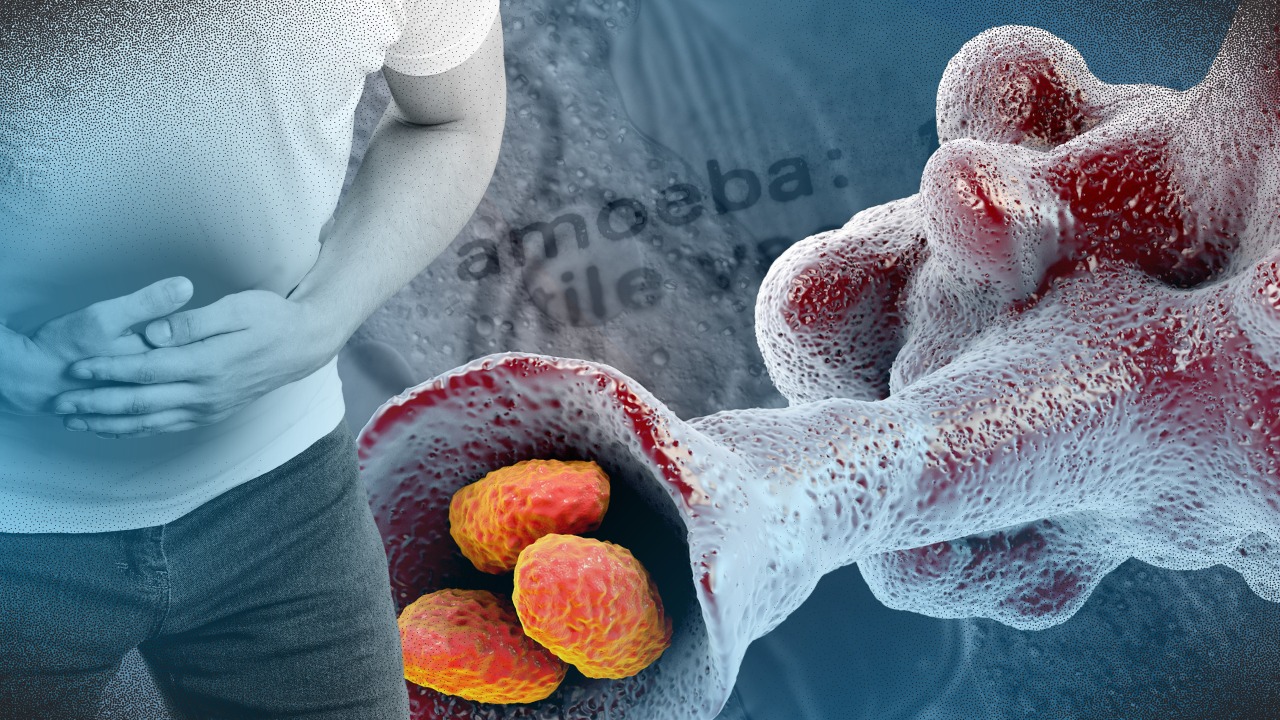
COMPOSITE IMAGE: JEROME CRISTOBAL FROM INQ STOCK PHOTOS
MANILA, Philippines—With cases of amoebiasis rising in San Carlos City, Negros Occidental, the Department of Health (DOH) said it already sent epidemiologists to look into the outbreak that prompted the local government to declare a state of health emergency.
Health Undersecretary Maria Rosario Vergeire, acting health secretary who stressed that the DOH was still in the process of verifying the outbreak, said “we are now sending our team […] to go to our Region VI office to help our regional epidemiology and surveillance units.”
Based on local government data, there were 203 cases of amoebiasis in 10 barangays from Jan. 1 to Feb. 24, 2023. While the number of cases last year was not disclosed, Mayor Renato Gustilo said it was not as many.
READ: Negros Occidental’s San Carlos City declares health emergency
However, Vergeire, last Feb. 28, said 189 cases have been tested and only 60 percent yielded a positive result for amoebiasis. The rest of the cases, she said, tested positive for a different bacteria, like Escherichia coli or e-coli, which is found in human and animal feces.
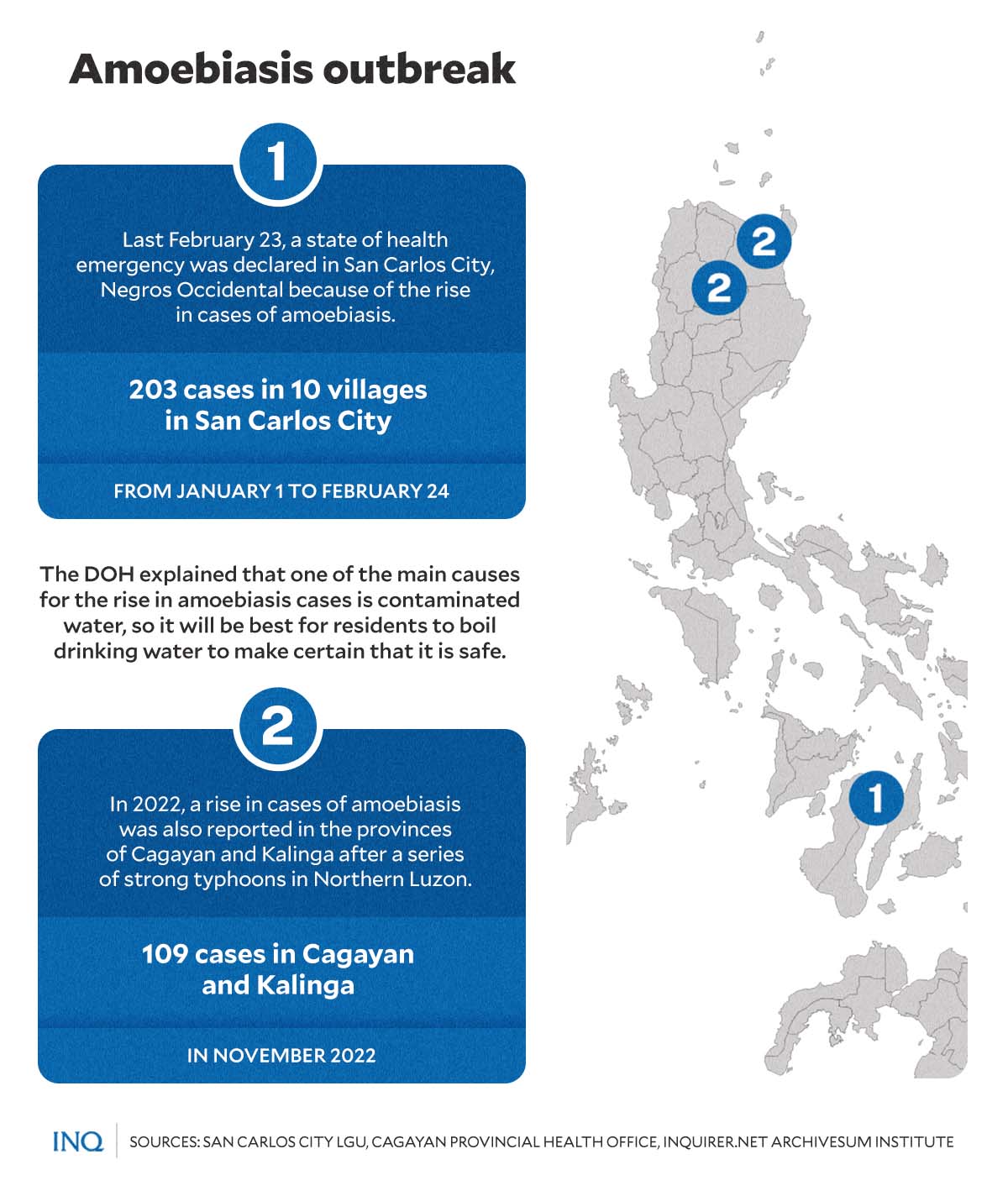
GRAPHIC Ed Lustan
She stressed, though, that the cases started in February and “we are seeing that the [number of] cases are rising.” DOH epidemiologists traveled to San Carlos City last March 1.
Article continues after this advertisementIn 2022, 109 residents, most of them children, in the provinces of Cagayan and Kalinga had been also hit by symptoms linked with amoebiasis after a series of strong typhoons that hit Northern Luzon.
Article continues after this advertisementREAD: Amoebiasis hits over 100 residents in Cagayan, Kalinga
But what is amoebiasis, which Vergeire said spreads through contaminated water?
E. histolytica
The United States Centers for Disease Control and Prevention (US CDC) said amoebiasis is an infection of the intestines caused by a one-cell parasite called Entamoeba histolytica.
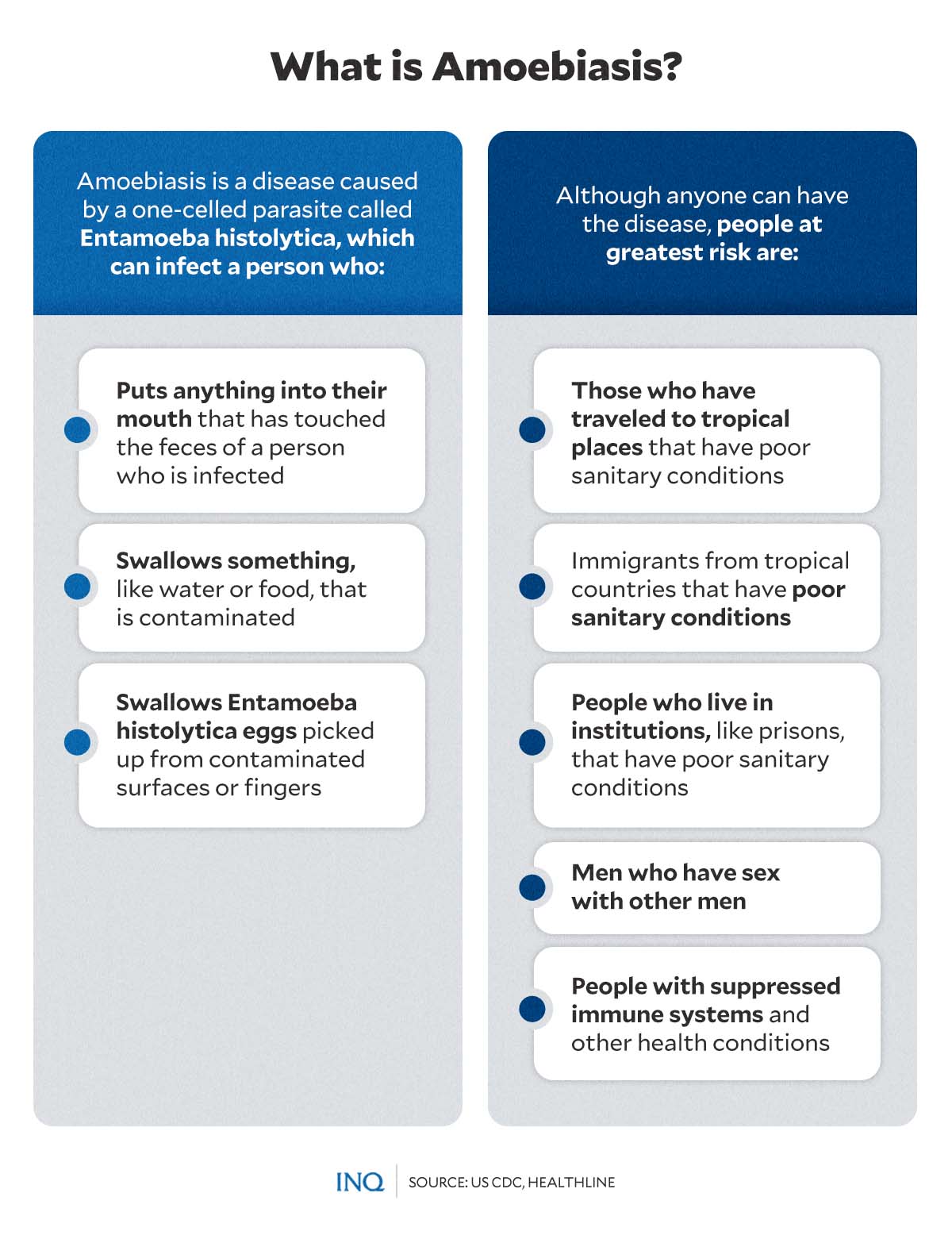
GRAPHIC Ed Lustan
It explained that although anyone can be infected, “it is more common in people who live in tropical areas with poor sanitary conditions.” People at greatest risk for amoebiasis include:
- Those who have traveled to tropical places that have poor sanitary conditions
- Immigrants from tropical countries that have poor sanitary conditions
- Those who live in institutions, like prisons, that have poor sanitary conditions
- Men who have sex with other men
- People with suppressed immune systems and other health conditions
As explained by the medical website HealthLine, the parasite is a single-cell protozoan that usually enters the body when a person ingests eggs through contaminated food or water, or when a person gets direct contact with fecal matter.
“The cysts are a relatively inactive form of the parasite that can live for several months in the soil or environment where they were deposited in feces. The microscopic cysts are present in soil, fertilizer, or water that’s been contaminated with infected feces,” HealthLine said.
HealthLine said food handlers may transmit the cysts while preparing or handling food. Transmission is also possible during anal sex, oral-anal sex, and colonic irrigation, which doesn’t come without risks.
“When cysts enter the body, they lodge in the digestive tract. They then release an invasive, active form of the parasite called a trophozoite. The parasites reproduce in the digestive tract and migrate to the large intestine,” it said.
The US CDC said the bacteria can infect a person who:
- Puts anything into the mouth that has touched the feces of a person who is infected
- Swallows something, like water or food, that is contaminated
- Swallows Entamoeba histolytica eggs picked up from contaminated surfaces or fingers
Amoebiasis in PH
Based on the 2019 to 2023 Food and Water-Borne Disease (FWBD) Prevention and Control Program Strategic Plan of the DOH, the goal of eliminating FWBD outbreaks, including amoebiasis, was not realized from 2012 to 2016.
This, as the DOH still documented several outbreaks in some parts of the Philippines, with amoebiasis comprising most of the health events in 2012 (40 percent), 2014 (26 percent), 2015 (30 percent), and 2016 (53 percent).
As the DOH said, there were 385 cases and 5 deaths in 2012, 83 cases with no death in 2013, 389 cases and 3 deaths in 2014, 284 cases and 5 deaths in 2015, and 2,268 cases and 12 deaths in 2016.
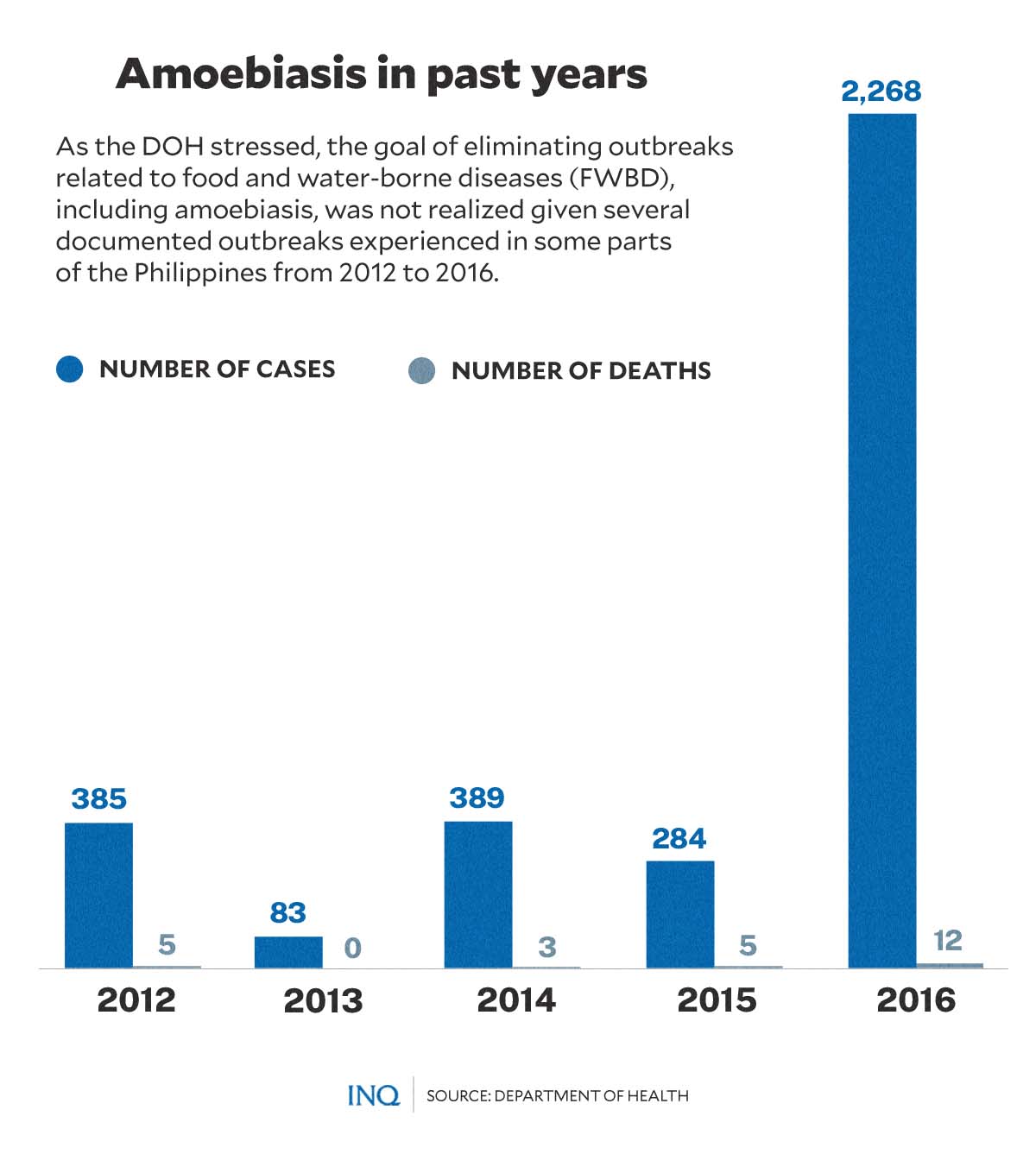
GRAPHIC Ed Lustan
Back in 2015, 72 individuals had been medically attended after contaminated water sent 72 residents in Aleosan, North Cotabato into fits of vomiting, diarrhea, and stomach pain.
READ: Villagers in North Cotabato downed by contaminated water
It was learned by the Aleosan District Hospital that the patients’ source of drinking water was a communal and open water well. All of them tested positive for the parasite or amoeba.
Last year, two inmates in Kidapawan City, which is still in North Cotabato, died while eight more had been hospitalized because of the disease. The inmates complained of stomach pain and loose bowel movement.
READ: Two inmates die, eight in hospital due to amoebiasis in Kidapawan
What are the symptoms?
US CDC said only about 10 percent to 20 percent of people who are infected with the bacteria become sick from the infection. Those people who do become sick usually develop symptoms within 2 to 4 weeks, though it can sometimes take longer.
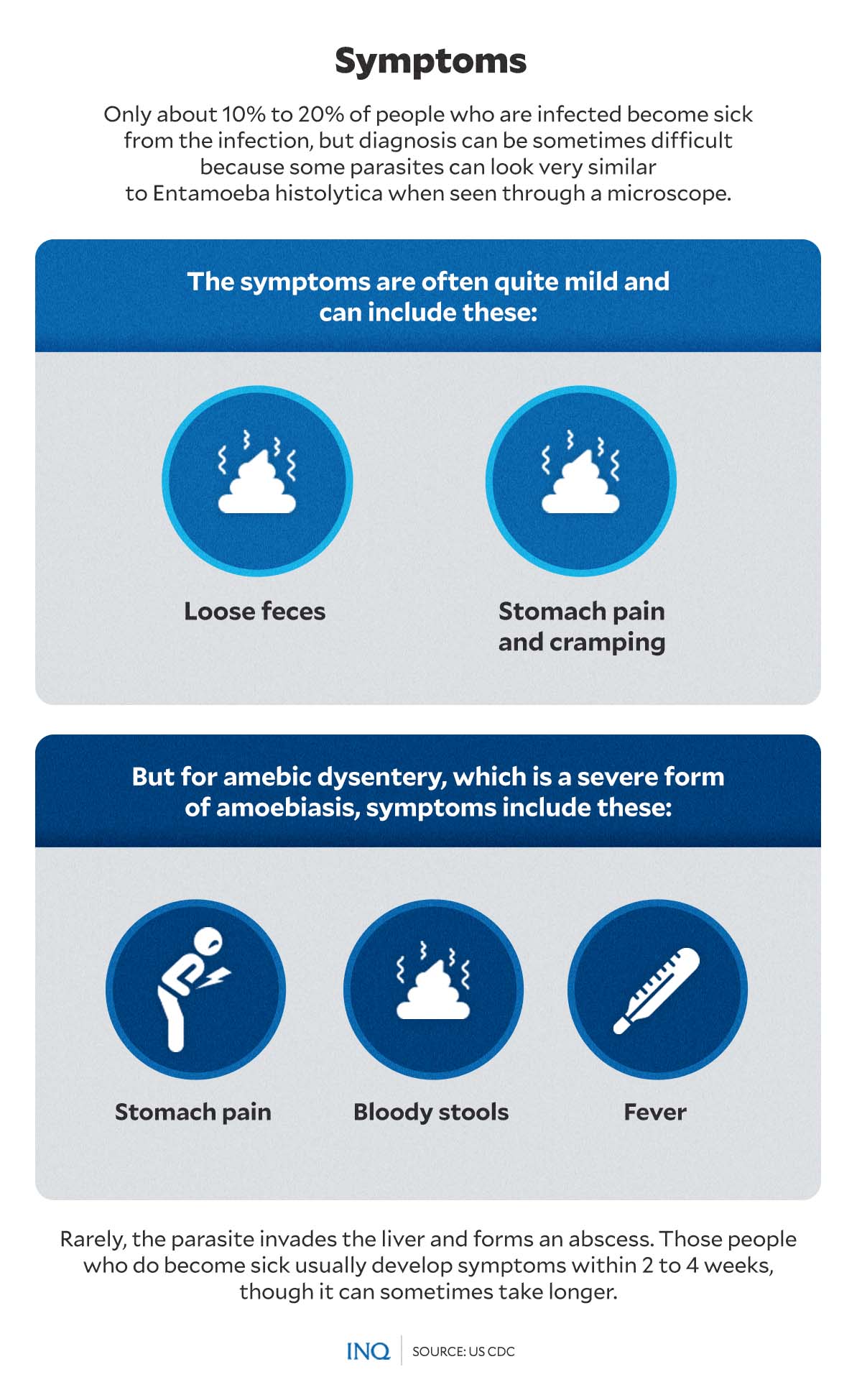
GRAPHIC Ed Lustan
“The symptoms are often quite mild and can include loose feces, stomach pain, and stomach cramping,” it said. But amebic dysentery, which is a severe form of amoebiasis, is associated with stomach pain, bloody stools, and fever.
Amebic dysentery is possible when the parasite invades the lining of the intestine. It is said to be “more dangerous.” One more complication is fulminant necrotizing amoebic colitis, which can destroy bowel tissue and lead to bowel perforation (holes) and peritonitis, or inflammation of the peritoneum, the lining that protects the abdomen.
Rarely, the parasite invades the liver and forms an abscess and in a small number of instances, it has been shown to spread to the other parts of the body, such as the lungs or brain, but this is very uncommon.
To diagnose if one is afflicted with amoebiasis, a health care professional will ask for fecal samples. But why over one sample? It’s because Entamoeba histolytica is not always found in every sample.
The US CDC said, though, that diagnosis of amoebiasis can be very difficult since some parasites and cells can look very similar to Entamoeba histolytica when seen through a microscope.
“Sometimes people are told that they are infected with Entamoeba histolytica even though they are not. Entamoeba histolytica and another amoeba, Entamoeba dispar, which is about 10 times more common, look the same when seen through a microscope,” US CDC said.
Treatment
As HealthLine said, “if tests detect the presence of Entamoeba histolytica, amebiasis needs to be treated regardless of whether you’re experiencing symptoms or not.”
The treatment generally consists of the following:
- If you have symptoms, you’ll follow a 10-day course of the antiamoebic drug metronidazole (Flagyl) that you’ll take as a capsule, followed by an antibiotic such as diloxanide furoate or paromomycin.
- Your doctor may also prescribe medication to control nausea if you need it.
- If you do not have symptoms, you may be treated with antibiotics.
- If the parasite is present in your intestinal tissues, the treatment must address the organism as well as any damage to your infected organs.
- Surgery may be necessary if the colon or peritoneal tissues have perforations.
Amoebiasis generally responds well to treatment and should clear up in about two weeks.
But most importantly, to prevent amoebiasis, it said “proper sanitation is the key,” stressing that “as a general rule, thoroughly wash your hands with soap and water after using the bathroom and before handling food.”
Likewise, as stressed by Vergeire, the DOH is set to coordinate with the local government of San Carlos City, the Department of Environment and Natural Resources, as well as other government agencies to address the possible contamination of the city’s water source.